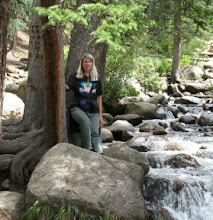We’re all so busy… who has time for blogging? Evidently, a large number of us do, and we know it’s great. But how do you explain the fascination to someone who hasn't tried it, or doesn’t get it? Here’s my attempt, but I’ll look forward to hearing more ideas from the rest of you. (This post is for those to whom I’ve promised to send my list of interesting links.)
1. You like to write. Some of us can’t help writing. It’s a disease. It may even be infectious, because bloggers seem to inspire each other to write more. Before I joined the blog world, I would have thought writers (and even thinkers) were relatively rare. Now I know better—there are, just in my limited experience, dozens of amazing writers in the blog world. Thank you all!
2. You like to read. Some of us will read cereal boxes if there’s nothing else available. Reading blogs is a far better use of your time.
3. You don't like to write--or read.If you're not into writing, try lurking, being a blog voyeur of sorts. If you don't even like to read, try a photo-blog. Several good ones are listed at
Tuesdays Photos.
4. You like people. You meet the nicest people online! Join—or create—a virtual network. Find one person whose blog you like, and let him/her lead you to other like-minded (but very different) individuals. I found a blog carnival,
I and the Bird, and met some real birders and great people, like
10,000 Birds,
Birdchick,
Carel,
Coturnix (who recently went pro-blogger),
Nuthatch, and
Dharma Bums.
Endment found me from
IATB, and introduced me to
Cate the Bean Counter,
Willow Grace,
DebR,
Tammy,
Fran, and
Susan and
Jennifer (see Haiku Monday under #6), among her many fans.
5. You don’t like people, but you want to. The internet, like the world, like life, is filled with the good and bad, the ugly and the beautiful. It is, in short, whatever you choose to make it. If you’re selective, you will find something online that matches (or challenges!) your interests, your biases, your understanding. And helps you grow. Browsing blogs can restore your faith in people. Could probably destroy it too, but I’ve been focusing on uplifting arenas, and I’m charmed by what I find. Please note: Most of my blogging has been science-nature oriented, so you'll have to find your own way in other arenas. Art, culture, politics, crafts,
parenting,
celebrity, music,
cooking, unimaginable diversity!
6. You’re bored. Need something to do? How about
Sunday Scribblings,
Haiku Monday,
Tuesdays Photos,
Poetry Thursday,
Illustration Friday? That only leaves you Wednesdays and Saturdays to be bored, and a little browsing is likely to fix that as well. (Who could be bored?) Fun and games? Try a meme, like the
letter B, or
The ABCs of Me, or
Wordplay.
7. You’re nosey. Blog-browsing is like eavesdropping on the lives of strangers. We can only learn so much from our one (current) lifetime, why not learn from the lives of others as well? Especially because we can learn things we will never personally experience. The more you learn, the more you blog—and you can share what you learn each week at
Life’s Little Lessons.
8. You wish you could travel more. You can, even if you only have a few minutes, go anywhere in the blog world—free! Blogs hosted on blogspot.com often have a small “Next Blog” button at the top of the page. Click on it, and see where you end up! Can’t read Malaysian? Click again for another random page somewhere else in the world. Or use the “Search” feature to find blogs from Tasmania or Lapland. Remember, one nifty blog leads to many others (think Six Degrees of Separation). In 3 clicks, I think it was from I and the Bird, I discovered
Baghdad Burning, an inside look at what’s really happening in Iraq that the newscasts aren’t telling us.
We all should be reading this!9. You want to escape reality. You could use the “Search” button again to find fantasies or science fiction worlds. But remember, someone else’s reality can also be your fantasy—see number 7.
10. You want to immerse yourself in reality. If you think your life is too boring, start a blog. Then you’ll have to find something interesting to do, just to blog about it!
11. You could use a little therapy. As someone said “I write to find out what I’m thinking.” Expressing yourself in a blog, as in a journal or a letter to a friend, can help you figure out what you’re about cheaper than—and probably faster than—conventional psychotherapy.
Okay, this has taken most of the morning, so breakfast will now have to be lunch. More links another time--this is more than enough to get you started!
 When I put out suet earlier this week, I was hoping it would help out the woodpeckers and flickers. Instead, this little Downy Woodpecker decided to go for the thistle seed!
When I put out suet earlier this week, I was hoping it would help out the woodpeckers and flickers. Instead, this little Downy Woodpecker decided to go for the thistle seed! Three Juncos wait their turn at the thistle feeder, while the Downy gets his fill.
Three Juncos wait their turn at the thistle feeder, while the Downy gets his fill. I was scanning too far afield, and in the trees. Finally, I spotted him, just a few feet from the bedroom window (note the indoor potted plant), with an unlucky Starling for breakfast, right on top of the birdseed just put out for the little ones. The spots mark "him" as Speck, our new local Sharp-shinned Hawk. He soon took off with his meal, so I never got a better shot.
I was scanning too far afield, and in the trees. Finally, I spotted him, just a few feet from the bedroom window (note the indoor potted plant), with an unlucky Starling for breakfast, right on top of the birdseed just put out for the little ones. The spots mark "him" as Speck, our new local Sharp-shinned Hawk. He soon took off with his meal, so I never got a better shot. When I put out suet, it attracts Black-billed Magpies. So here's a small challenge for you. How many pie-birds in this picture? Answer will be posted tomorrow. (Remember, you can click to enlarge the photo!)
When I put out suet, it attracts Black-billed Magpies. So here's a small challenge for you. How many pie-birds in this picture? Answer will be posted tomorrow. (Remember, you can click to enlarge the photo!)















































